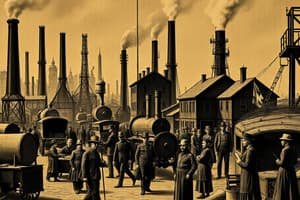Podcast
Questions and Answers
When was the transcontinental railroad completed?
When was the transcontinental railroad completed?
1869
Which three factors transformed industry during the Gilded Age? (Select all that apply)
Which three factors transformed industry during the Gilded Age? (Select all that apply)
- Increased agricultural production
- The rise of new technology (correct)
- The use of new business models (correct)
- The expansion of railroads (correct)
What outcome did industrialization during the Gilded Age lead to in the United States?
What outcome did industrialization during the Gilded Age lead to in the United States?
Increased urbanization
What characterized the period known as the Gilded Age?
What characterized the period known as the Gilded Age?
What was the U.S. population approximately in 1900?
What was the U.S. population approximately in 1900?
In which region had the most miles of railroad during the respective decade?
In which region had the most miles of railroad during the respective decade?
How can J.P. Morgan be best described?
How can J.P. Morgan be best described?
How did railroad expansion affect the prices of goods during the Gilded Age?
How did railroad expansion affect the prices of goods during the Gilded Age?
In the late 1800s, the Bessemer process was primarily used in what industry?
In the late 1800s, the Bessemer process was primarily used in what industry?
What were the investor-owned businesses that developed in the 1800s called?
What were the investor-owned businesses that developed in the 1800s called?
Flashcards are hidden until you start studying
Study Notes
Transcontinental Railroad
- Completed in 1869, revolutionizing transportation across the United States.
Factors Transforming Industry
- New business models, technological advancements, and railroad expansion played crucial roles in transforming industry during the Gilded Age.
Urbanization During Industrialization
- Industrialization led to significant urban growth as people moved to cities for jobs and opportunities.
Gilded Age Characteristics
- The Gilded Age was marked by rapid economic growth and significant technological changes.
U.S. Population Growth
- U.S. population grew from nearly 40 million in 1870 to almost 80 million by 1900, indicating substantial demographic shifts.
Railroad Expansion
- Expansion of railroads was particularly notable in the Western states, facilitating trade and migration.
J.P. Morgan's Role
- J.P. Morgan was a prominent banker and financier known for organizing corporate mergers and consolidations.
Impact of Railroad Expansion on Prices
- The cost of shipping goods by railroad was significantly lower, resulting in decreased prices for consumer goods.
Bessemer Process in Steel Production
- The Bessemer process, developed in the late 1800s, was pivotal in the mass production of steel, enhancing industrial capabilities.
Rise of Corporations
- The growth of industry led to the establishment of investor-owned businesses known as corporations, changing the business landscape.
Studying That Suits You
Use AI to generate personalized quizzes and flashcards to suit your learning preferences.




